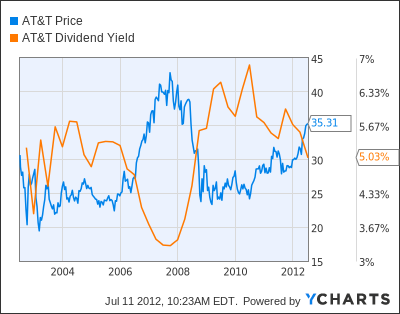Before we dicuss how the mechanism of dividends keeps the stock, and by extension market, somewhat rational…we need to review what we have learned thus far about the sneakyisms of Wall Street.
Part 1 discussed the necessity of having dividends to anchor share prices to company fundamentals. Part 2 showed why share buybacks are an inferior method of transferring wealth from firm to shareholder – and that is if you believe that it succeeds in doing that at all. The third segment in this Wall Street expose is to show how dividends work in creating ballast for your investment vehicle which will keep your portfolio afloat.
Dividends and a Zero Growth Economy
To illustrate this, assume that the economy falls into zero growth and stays that way perpetually. Does this mean that it is impossible to make money investing? Not at all. But consider two companies – one is a defensive dividend stock and the other was formerly a high growth tech stock:
- Defensive Dividends: $100 per share. Earnings yield of 10% (PE of 10). Payout ratio 50% (dividend yield 5%)
- Techie Titan: $100 per share. Earnings yield of 5% (PE of 20). No dividends
If you invested in the Defensive Dividends stock you would be locking in a 5% yield and there is the potential to get up to a 10% dividend yield if payout ratios are boosted. Remember we are assuming zero earnings growth.
Will share prices fall? Maybe but likely not fall too far as it forces the yield up. In a no growth economy, it is unlikely that investors wouldn’t be interested in a 10% yield in a company with defensive earnings. This would provide lift to the prices to bring yield back down thus protecting your capital.
But where is the floor in the Techie Titan? If they offer dividends you’ll likely see prices fall in half since a 50% payout ratio at current valuations is only a 2.5% dividend yield. If they didn’t offer dividends…what is the worth of this no-growth company? It could be much lower indeed.
Dividends provide support for share prices. Dropping prices mean bigger yields which increases attractiveness for investors. Granted, if the profit falls or the dividend is cut, this can create more downward pressure. But all things being equal, a decent yielding dividend stock has more ballast in the share price than a non-dividend stock.
Look at China small cap stocks and how low valuations can get since they refuse to pay dividends. If these firms paid dividends – even a small one – the prices would be supported at much higher levels. Even in risky stocks people are willing to invest, even if only a small amount, when yields start getting in the high teens and low 20s.
Jumping Yields and Price Support
Some investors time their purchases by looking at dividend yield compared to historical averages. When hte yield gets too high they start buying. When yields get too low due to rapid share price advance, they go back to saving up cash. Look at the company AT&T (T) and note how you could have made money by simply buying systematically when yields broke above 5 – 5.5% and holding.
When the sky was falling in 2008 and 2009, a dividend yield on AT&T above 6% seemed to be the sweet spot for investors to jump on board.
Granted, dividends are derived from profit and profit is not a constant that we can plot. This means that we cannot dogmatically say that you should buy high-yield stocks that are well above their 5 year average since revenue and earnings might be shrinking at this is being priced in advance. But the point I am trying to make is how a dividend policy can provide a bottom floor that will attract investors when prices fall too far.
This is your ballast since there is a direct link between lower share prices and higher income streams. Dividends help create an equilibrium between share price and income for a smoother ride.
Paying Dividends Creates Deep Value
In addition to dividends being a transparent and fair method of transferring company wealth to shareholder and creating a tangible link between firm value and share price, it is also a useful mechanism to keep your dividend yields strong. How so?
It is important to remember that dividends come from profit. The lower the price is in relation to profit the higher the dividend you can achieve. Wouldn’t it be good if we could keep share prices down for a nice strong and consistent income payment? Sure, but how would you do so?
Prices typically only drop when earnings fall…right? Wrong. You can remove equity from a company and lower share prices which will boost your dividend yield…provided this removal of equity doesn’t directly lower future earnings. Here is an example…
- A certain utility company trades at $12 per share. The payout ratio is 80% and the dividend is at $1 per share with small annual increases. This means the dividend yield is now at 8.3%. The company has been slowly accumulating cash and now has $2 per share in liquid assets. This is factored into the share price. If the company were to announce a one-time special dividend, what would happen to the share price? Shares must fall on ex-dividend date by the same amount as the dividend…anything less would work out as an arbitrage play in the short-term. No money made or lost…right? Well look at the picture with longer range lenses…
Let’s assume for simplicity sake that the $2 per share in cash and $1 per share profit are paid out all at once. This $3 per share removal of equity drops shares down to $9 as anything less will allow short-term profiteering.
Although the book value has dropped 25%, the future profits did not drop 25% or $1 to 75 cents. Even if profits remain the same, the price to earnings ratio is now more attractive despite the removal of equity.
Dividend yield is now 11% and the future earning potential remains the same. This means that you are either getting a better income return or that share prices need to bounce back up over the next while to maintain valuations. Either way this is a win/win situation for the shareholder and it doubles up as a protection that keeps executives and their stock options at a distance.
In fact, I would be even happier if the company could sell all its assets and give the cash to shareholders if future profits were not harmed. In a limited sense, this is what is happening when dividends are given back.
Prices are temporarily depressed (the opposite of open market buybacks) which creates deeper value in one of the only metrics that matters to dividend investors – the price to earnings ratio (and not price to cash/revenue/assets). By continually removing equity from the company, the share price's valuations are continually lowered, thus resulting in stronger support for capital gain and income yields combined. Academics wonder why there's a premium or extra market-wide performance on low price to book ratio stocks; maybe they should look into the dividend mechanism that lowers book value compared to the price to earnings ratio.
Now that we scratched the surface of the market and examined the importance of dividends for sane valuation and sustainable profit-taking, we are going to switch gears for a while and talk about the myth of risk.
What really is risk? Is it possible that financial experts that blow off all these fancy risk-adjusted ratios are really just blowing smoke into the air? Has Wall Street pulled the wool over your eyes again? Part 4 will reveal the answer.
